The CN Journal Sample Articles
Sinking of the Lusitania and the Karl Goetz Medal
by Randy Nelson, C.N.A. 15617 (Abstract)
The Lusitania left New York City on May 2, 1915 bound for England loaded with passengers and controversial cargo in its hold. Germany had started a series of newspaper ads the day she sailed reminding people that a state of war existed and that a war zone had been declared around the British Isles. On May 7, a German submarine fired a single torpedo sending the Lusitania to the bottom of the ocean with a loss of nearly 1,200 lives. This event helped to propel the United States into World War I. Shortly after the sinking, a German medalist, Karl Goetz, cast a medal chastising the Cunard Shipping Line for allowing passengers on a ship destined for the war zone around Great Britain. This medal was incorrectly dated May 5, 1915. Great Britain saw this as a planned attack rather than coincidental and seized the opportunity to copy the medal and sell it to the general public for propaganda purposes. As soon as Goetz realized his wrong date error, he cast a small amount of new medals with the corrected date.
The Building of the Lusitania
Great Britain had ruled the seas since Lord Nelson had defeated the combined French and Spanish fleets in 1805 during the Battle of Trafalgar. At the turn of the century, Germany was Britain's main commercial and maritime rival. Nations would compete with each other for the Blue Ribaud for the fastest Atlantic crossing. In 1897, Germany set a new world's record with a speed of 21.37 knots and again in 1903 with a crossing of 22.6 knots. Britain's reputation was fading quickly.
These speed records and the fear that Germany would mount guns on her ships in the event of war breaking out prompted the British government to lend Cunard Shipping £2,600,000 to start building the Lusitania and her sister ship, the Mauretania. Admiralty specifications required that the deck plans included pillars and supports for the placement of 12 six inch guns with gun shields if war broke out.
When the Lusitania was launched on June 7, 1906, she was the largest and fastest ship built at the time. Her length was 785 ft. with a beam of 88 ft. Her displacement was 32,500 tons. At top speed she could do better than 25 knots. People fondly nicknamed her the Greyhound of the Sea. Her maiden voyage was on September 7, 1907 and a month later, in October, she won back the Blue Ribaud for Great Britain. The next nine years saw the Lusitania cross the Atlantic 100 times. Her final voyage was on her 101st crossing.
War Warnings
Six months before war was declared, Winston Churchill, who was the First Lord of the Admiralty at the time, told the House of Commons that 40 merchant ships had been armed with 4.7 inch guns strictly for defensive purposes only. Two months later, Churchill informed parliament that these armed merchant cruisers could be commissioned as ships in the Royal Navy when war broke out.
War was declared on August 4, 1914. In February, 1915 Germany announced an "area of war" in the waters surrounding Great Britain and Ireland. They announced that any ship sailing in this area could be subject to search, seizure, and possible sinking. The United States declared their neutrality and did not want to get involved in the war overseas. They did announce, with their "Strict Accountability" memo to Germany (February 10, 1915), that if any Americans were killed, there would be consequences to pay.
In America, German-Americans, German agents and officials met in New York City in April of 1915. They were concerned about the wrath of the U.S. if any American lives were lost. The 1915 travel season was about to begin. They agreed to publish a series of warnings on the travel page of a number of U.S. newspapers. This warning would announce again that a state of war existed and that passengers travel at their own risk. The first ad was to appear on April 24 but not all of the targeted 40 newspapers could be reached therefore the first ad didn't appear until May 1, the day the Lusitania sailed. The ad made little difference to the passengers.(Bailey, 1975).
The Cunard Company, who owned the Lusitania, had a smug attitude when it came to these warnings. Surely, their "greyhound," which just set speed records of 25 knots, couldn't be caught by a relatively slow submarine. The New York offices were so unconcerned that they didn't even bother contacting their head office in Liverpool (Bailey, 1975). The Lusitania deck plans included areas for mounting deck guns but the Admiralty changed their mind when they realized that the cost of fueling such a big ship was out of proportion with the usefulness of arming.
The Sinking
The Lusitania left port in New York City on the morning of May 1 and the trip across the Atlantic was uneventful. To conserve coal, six of the 25 boilers had been shut down reducing her top speed of 25 knots to 21 knots (Simpson, 1972). In the afternoon of May 6, the Lusitania received the first wireless transmission concerning submarine activity off the coast of Ireland. It was acknowledged by the Lusitania. A second wireless came that evening about 8 p.m. This wireless contained an explicit order from the British Admiralty to all British ships. All ships were to avoid headlands, pass harbours at full speed, and to steer a mid channel course. The next morning, May 7th, this same warning came six more times. Captain Turner ordered two extra lookouts. It should be noted that there were intermittent fog patches. The Lusitania was slowed from 21 knots to 18 and finally to 15 knots. It was standard practice for ships to zig zag when traveling through submarine infested waters. Captain Turner failed to do this as he wanted to time his arrival in Liverpool at high tide so that he could enter the Mersey River without stopping (Bailey, 1975).
Early in the afternoon of May 7, Captain Turner could see the Irish coast but was uncertain of his exact position. He ordered the ship to change course and to head closer to land so he could fix his position. At 1:40 p.m. he recognized the Old Head of Kinsale. Lusitania swung back to her old course.
Little did Captain Turner know that he was being watched through a periscope. Captain Schwieger of the German submarine U-20 felt that he would be unable to get a shot at her as the Lusitania was steaming away from him and he would be unable to catch her. He was amazed when she suddenly changed course and was heading straight toward him. He got into position and waited. At approximately 700 yards, Schwieger fired a single torpedo. At 1:50 p.m. the lookouts spotted it but there was no time to turn the great ship. Seconds later it hit between the first and second funnels. Almost immediately a second explosion was heard throughout the ship. In 1993, Dr. Robert Ballard, using modern robotics and cameras examined the Lusitania and discovered that this second explosion was not a result of the boilers exploding but probably was the result of exploding coal dust. The ship immediately began to heavily list to starboard making it impossible to lower boats on the port side. Captain Turner gave the order to turn the ship towards the coast in hopes of beaching her but power had been cut by the explosions preventing communication with the engine room and passengers in the lower decks. The Lusitania still steamed ahead preventing lifeboats to be launched safely. It is estimated that the Lusitania was carried forward by its momentum for another two to three miles (Snyder 1965). Eighteen minutes after the torpedo struck, Lusitania sunk with a roar. Hundreds of passengers and crew were trapped below decks or on elevators. Others were swept off the ship and drowned in the turbulent waters as she sunk. One thousand, one hundred and ninety-eight people lost their lives. Of these, 128 were Americans. The most celebrated American casualty was multi-millionaire Alfred Vanderbilt who, three years earlier was booked on the Titanic but had a change of plans at the last minute.
Aftermath
The British denied suspicions that the Lusitania was carrying contraband even though she was. A portion of her manifest, kept secret until the 1950s, listed 2,400cases of Remington rifle cartridges, 1,248 cases of three foot shrapnel shell cases (non-explosive), and 18 cases of non-explosive fuses (Taylor, 1999). In Britain the reaction to this sinking was immediate, mobs attacked German owned shops in London and Liverpool. Even though the Americans had warned Germany that there would be consequences to pay if any American lives were lost, there were still calls for restraint by the government. The United States was simply not quite ready to enter the war.
In August, an other British ship was torpedoed with the loss of two American lives. The German government promised the U.S. on September 1, 1915 that no more merchant ships would be sunk without warning (Taylor, 1999). The threat of U.S. intervention receded. However, the British blockade still continued. More than a year later, on January 31, 1917, Germany announced that it would resume unrestricted submarine warfare to break the British blockade. By mid-March, five unarmed American freighters had been sunk with a loss of 36 American lives (Bailey, 1975). The United States declared war on Germany on April 6, 1917.
Karl Goetz
Karl Goetz was born in 1875 in Augsburg, Germany. He started his formal education in art in his home town and continued his studies in schools of art in Dresden, Leipzig, Berlin, and Dusseldorf from 1895 and 1897. The next two years was spent in Holland before moving to Paris where he lived for five years. In 1904, he moved to Munich where he lived for the remainder of his life. Goetz lived a fairly active life. Not only was he a full-time artist, he also belonged to several organizations. These included the Munich Artists' Society, The Numismatic Society, The Ancient Club of Munich, and the Artrian Association for Numismatics of Vienna.
During his lifetime, Goetz created 633 medals, of which 175 were of a satirical nature. Many of these were created for friends when they celebrated personal events in their lives, like weddings and birthdays.
The awards that Goetz received in his lifetime for his art included the State Medal in silver at Nuremberg (1906), the State Medal at Ghent (1913), and, awarded posthumously, the Silver State Medal of the World Exposition in Madrid in 1951.
By the late 1940s, paralysis set in his right hand as a result of a stroke but he continued his work for as long as he could. At the time of his death in 1950, the entire right side of his body, was paralyzed. He was 75 years old.
The Controversial Medal
Ever since Goetz first cast his Lusitania medal, controversy has surrounded it. Although his original intention was to merely create a metallic political cartoon, it was used by the British as propaganda against Germany which helped propel the United States into World War I. The medal features the Lusitania sinking (incorrectly) by its stem with guns and airplanes on its decks. Above this picture are the words Keine Bann Ware! (No Contraband Goods!). Beneath this, in the exergue is the words (DER GROSS DAMPFER LUSITANIA DURCH ElN DEUTSCHES TAUCHBOOT VERSENKT 5 MAY 1915), (The liner Lusitania sunk by a German Submarine May 5, 1915). The reverse shows a line of people at the Cunard Lines ticket office (FAHRKARTEN AUSGABE) buying tickets from a skeleton (representing death). In the line of people is a man reading a newspaper with the headlines warning of U-boat danger (U BOOT GEFAHR). Beside this man is a top hatted and bearded figure raising a warning finger. This represents the German Ambassador to the USA, Count Johann-Heinrich von Bernstorff warning the American people about being passenger on a ship destined to be sailing in war zone waters. Above him are the words GESCHAFT UBER ALLES (Business Above All). Goetz included this as a satirical slogan of Cunard Shipping. The designer's initials (K.G.) appear below this.
There are three different varieties of the medal. The first was Goetz's original medal with the incorrect MAI 5, 1915 date. The second is Goetz's corrected date medal, MAl 7, 1915. The final variety is the English copy with the English spelling of the date, MAY 5, 1915.
Goetz created his medals from his home and would sell them wherever he could. As such, the mintage figures were never the same. The more popular medals would have greater sales so he would make more. Poor selling medals would be melted down and the metal would be recast as other medals. Mintage figures for most of Goetz's pieces were lost during the bombing raids on Munich during the war (Kienast, 1967). However, in personal correspondence with the German Embassy in London via the State Department of Bavaria, Goetz mentioned how many Lusitania medals were cast up to that time. As of September 1920, 430 pieces had been cast (Kienast, 1967). It's unclear if this amount includes both versions of his medal or just the original incorrectly dated medal. Simpson (1972) stated that only 41 of the MAl 7, 1915 medal were made. Unconfirmed reports from the Internet has put this figure at 45. In any case, very few were made.
In a letter written by Goetz in 1921, he stated that the medal was cast for the first time in August 1915. Shortly after this, one fell into the hands of the British. They felt that the Germans had planned the sinking of the Lusitania and the earlier date on this medal proved it. Not wanting to pass up a perfect propaganda opportunity, they copied it and sold it to the general public at a cost of a shilling each. The proceeds of the sale of these medals went to the St. Dunstans Blinded Soldiers and Sailor's Hostels and the Red Cross (Imperial War Museum Online, 1999) Under the directions of Captain Reginald Hall, the Director of British Navel Intelligence, the British struck 300,044 of these medals (Simpson, 1972). Bailey (1975), however, states that only 250,000 of the English version was struck. This newly copied English version came in an attractive cardboard box with a picture of the Lusitania on the top. The lid also tells how the Lusitania was sunk and gives the date. Inside the lid are the words The Lusitania Medal. An exact replica of the medal which was designed in Germany and distributed to commemorate the sinking of the Lusitania. (This indicates the true feeling the War Lords endeavour to stimulate, and is proof positive that such crimes are not merely regarded favourably, but are given every encouragement in the land of Kultur). The Lusitania was sunk by a German submarine on May 7th, 1915. She had on board at the time 1,951 passengers and crew, of whom 1,198 perished."
Also included in this box was a pamphlet describing the medal and tells how "evil" the Germans are by offering quotes by German officials such as "With joyful pride we contemplate this latest deed of our navy... Kolnische Volkszeitung, May 10th, 1915." This paper goes on to describe how the designer put guns and airplanes on the deck of the ship but neglected to put on the women and children who were on board on the medal. After the reverse was described (the side showing passengers buying their tickets from the skeleton), the paper says that the medal "seeks apparently to propound the theory that if a murderer warns his victim of his intention, the guilt of the crime will rest with the victim, not with the murderer." This medal evoked emotion with the Allied nations (as it was intended to do) and the medal sold very well.
In response to this propaganda, on January 18, 1917, Baron von Speidel of the War Office of the Kingdom of Bavaria wrote a memo to the I, II, and III Army Corps telling them that the "further manufacture and sale of the Lusitania medal... is forbidden and any available pieces are to be confiscated." (Kienast, 1967) There is no record of how many were actually confiscated.
One obvious question that needs to be addressed is, "Why did Goetz put the wrong date on the medal to begin with?"
The answer to this is rather simple. Goetz received his information about the sinking from a newspaper account which reported the wrong date (Kienast, 1967).
Conclusion
The war ended three years after Goetz created his medal. The copied English version had done what it was made to do and that was to create hatred against the Germans. Goetz tried to explain his reasons for creating this medal by casting another medal explaining that it is hard not to write a satire but the damage had already been done. The U.S. entered the war and with their help, the English were able to crush the German blockade around the British Isles. A year after the war ended, Germany was forced to surrender their premier ocean liner, the Imperator to replace the Lusitania. Cunard renamed her Berengaraia (Bailey, 1975).
As for Karl Goetz, he continued to make medals for the remainder of his life until paralysis set in and he was unable to continue. Throughout his life, he kept having to defend his reasons for casting his Lusitania medal. Seventeen years after he first cast it, in 1932, he explained once again in a letter to Rear Admiral Lutzow why he cast it and why he cast it with the wrong date. In this letter he expressed regret that his medal was used by hostile foreign countries for propaganda purposes (Kienast, 1967).
Images
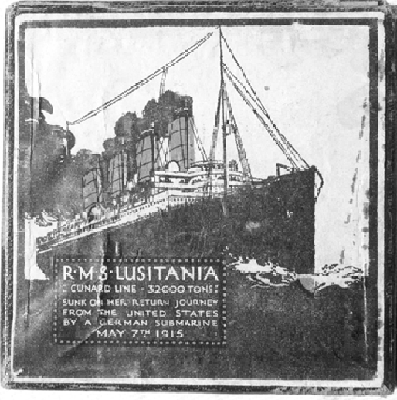
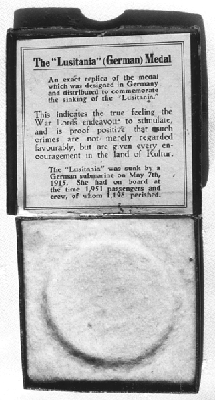

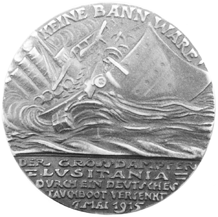
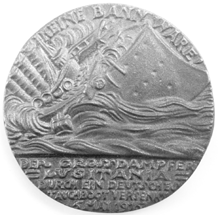

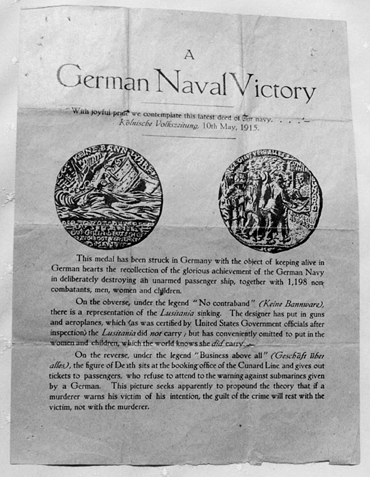

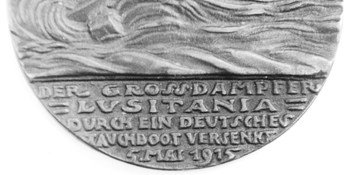
References:
Bailey, T.A. (1975). The Lusitania Disaster. New York: Free Press
Ballard, R.D. (1995). Exploring the Lusitania. New York Warner Books Inc.
Imperial War Museum Online Exhibition. The Lusitania Medallion. Retrieved March 5, 2000 from the World Wide Web at: http://www.iwm.org.uk/online/lusitan/lusi4.htm
Kienast, G.W. (1967). The Medals of Karl Goetz. Cleveland: Artus Company
Simpson, C. (1972). Lusitania. London: Longman Group Ltd.
Taylor, J.M. (1999, Spring). Fateful voyage of the Lusitania. MHQ: The Quarterly Journal of Military History, 18-27.
back to The CN Journal list of sample articles